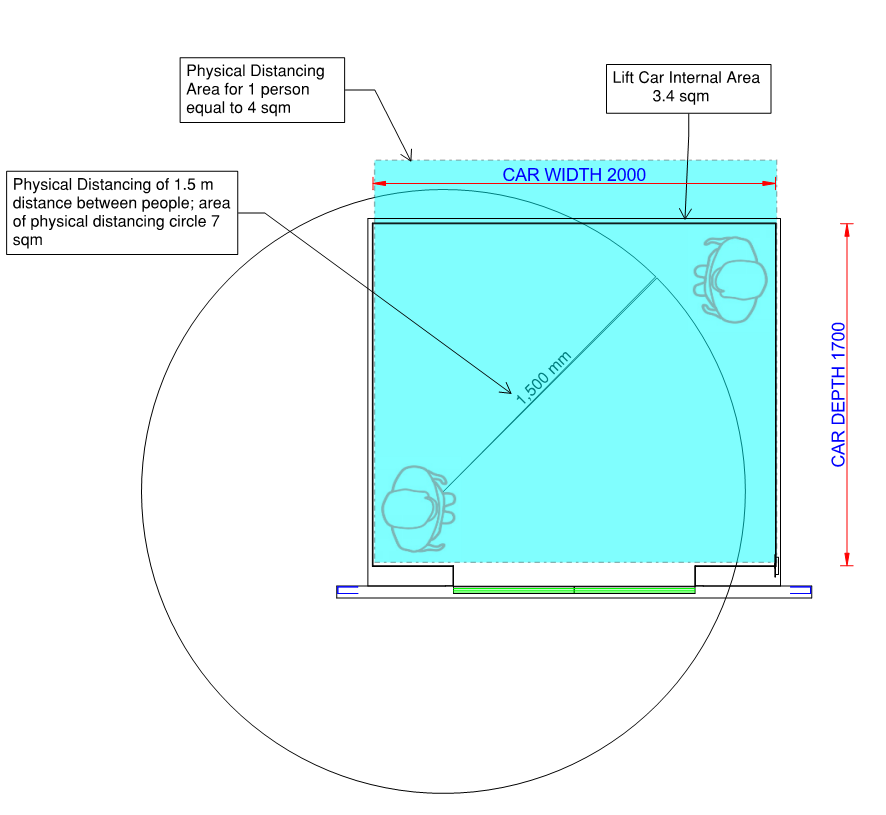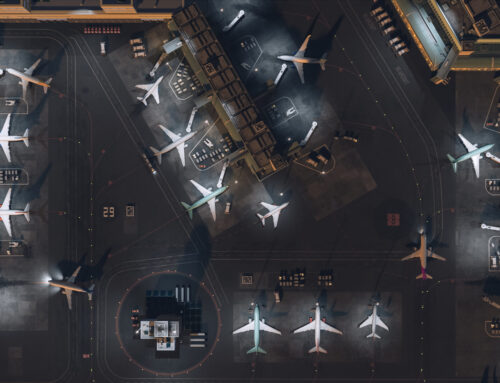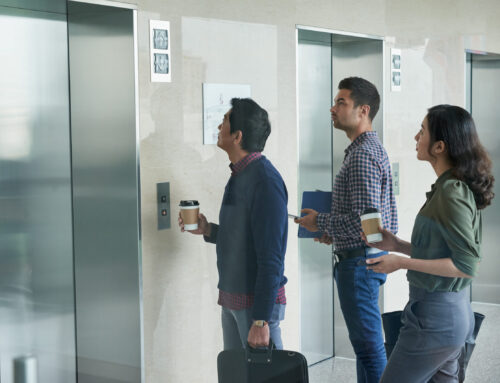With restrictions easing in many parts of Australia our focus is turning towards a return to the workplace. Safe Work Australia released guidelines consistent with the Department of Health’s physical distancing requirements; maintain 1.5 m distance from others and provide 4 sq m of area for each person where possible.
The following sketch illustrates these physical distancing requirements applied within a typical commercial office 21-passenger lift car of internal dimensions 2.0 m wide and 1.7 m deep, with 1.5 m distancing possible however 4 sq m per person is greater than the available car area.
 From the sketch, we can appreciate why Safe Work Australia’s guidelines confirm the restrictions may limit lifts to an occupancy of 1 or 2 passengers in a lift car at any time to meet the physical distancing requirements; for the avoidance of doubt for all users it would be good practice to identify standing zones with each lift car.
From the sketch, we can appreciate why Safe Work Australia’s guidelines confirm the restrictions may limit lifts to an occupancy of 1 or 2 passengers in a lift car at any time to meet the physical distancing requirements; for the avoidance of doubt for all users it would be good practice to identify standing zones with each lift car.
These requirements will have a significant impact on how people access and move through commercial office buildings to hospitals, universities and retail centres.
In commercial office buildings, a 21 passenger car similar to the sketch above, would be expected to transport up to 15 passengers in a morning up peak period to enable our offices to be loaded efficiently over a one hour timeframe.
With a reduced car capacity limited to two passengers per car, the time taken to fully occupy an office building will be significantly longer.
The impact is best explored stepping through an example building.[/vc_column_text][vc_column_text]Taking a commercial office building comprising Ground and 11 upper levels of 1,550 sq m each, occupied at 1 person per 12 sq m, this could be serviced by five, 21 passenger lifts using a destination control call algorithm and achieve a Property Council of Australia Premium Grade classification.
During the morning up peak, the peak design arrival rate would reach 14% of the building population, or 198 people, in a five-minute period with each lift carrying on average, 13 passengers.
The average waiting time during the period would be in the order of 23-25 seconds and an expected queue length of between 25 and 35 people may be expected (refer graphs below).


With car loading reduced to 2 passengers per lift the outcome is significantly different as the arrival rate of passengers very quickly exceeds the reduced capacity of the lift system, resulting in long waiting times and passenger queues in the Ground floor foyer (graphs below).


With a passenger queue length exceeding 600 people the required waiting area in the foyer to meet physical distancing requirements would need to accommodate a linear queue of at least 900 m or provide an area of at least 2,400 sq m. There is unlikely to be any commercial office buildings capable of providing the required space to accommodate these waiting passengers whilst meeting prescribed physical distancing requirements.
Until such a time as current physical distancing requirements are relaxed, there will be an onus on building owners and tenants to ensure workers and visitors can enter buildings safely. This will require a significant reduction in the arrival rate of people to office buildings to ensure the passenger demand does not significantly exceed the transportation capacity of the lift systems, in order to maintain acceptable queues in and around lift waiting areas.
To be successful, building owners need to determine the maximum steady state transportation capacity of the lift system in their building and ensure the arrival rate does not exceed this value.
Through simulation, the steady state transportation capacity can be determined by increasing the passenger demand incrementally until a time when the queue lengths and waiting times increase exponentially.
This is illustrated below for our example office building.

In this example, when the arrival rate exceeds 3.5% of the building population the queue length increases significantly indicating passenger demand is exceeding capacity. As such an arrival rate of 3.5% or more will generate significant congestion in the entry foyer with a risk of breaches in physical distancing requirements likely to occur.
With this limited capacity, the lift system will only be able to move approximately 42 people every five minutes during a morning up peak.
Restricting arrival rates to this level in buildings will be challenging for building owners, managers and tenants, but will be necessary, if current physical distancing guidelines are to be followed.
This example focuses only on the morning up peak period. Reducing car loading to two people per lift car will have a similar detrimental impact on lift performance during midday lunch peaks and evening down peaks, and should be considered by every building owner before a large scale return to the workplace occurs.
Despite the reduced lift performance imposed by physical distancing there are some measures building owners and tenants should consider to ease the transition back to office spaces including:
- Explore options to compartmentalise the lift car interior with clear perspex screens, similar to those being applied in retail, allowing more passengers to be transported per lift car. It may be possible to create three or four passenger compartments and significantly increase transportation capacity over those available under current restrictions.
- Review the lift car internal dimensions for your building to determine the number of passengers each lift car can accommodate whilst complying with physical distancing requirements. Place standing zone signage with 1.5 metre separation in lift cars noting the distance is measured from the outer most point of the body.
 (Australian Government, Department of Health)
(Australian Government, Department of Health)
Note: for a lift to carry 3 people per car in accordance with current physical distancing requirements it would have to have a rated load of at least 28 passengers.
- Stagger work hours for all employees in the building including arrival to work, lunch breaks and departures in the evening. It would be beneficial to provide each floor with a nominated timeframe for each peak period as this will limit the number of stops a lift will be required to make and restrict mixing of employees from different tenancies.
- Restrict passengers from waiting for lifts in the ground floor lift foyer; create waiting zones outside the foyer allowing passengers exiting lift cars sufficient space to exit lift cars without exceeding 4 sq m per person in lift lobbies (with a lobby width of around 2.5 m a five car lobby would have an area of around 20 sq m and only able to hold 5 people without breaking physical distancing requirements).
- To assist reduction in multiple users activation of landing calls consideration may be given to placing a Concierge on the main entry floor to enter calls for patrons to reduce the number of people touching lift call buttons/screens. If Concierge service is not offered building owners could encourage building occupants to use a personal stylus, or similar device, to activate lift call buttons where possible.
- A number of buildings have multiple building entry points at ground level therefore an opportunity exists to assign an entrance for tenants located within a lift group or rise (low, medium or high rise). This would enable building owners to monitor and control the arrival rate to the designated lift group and ensure the arrival rate does not exceed the lift transportation capacity. Buildings with a single lift group may designate alternate entry points as either building entry or exit points.
- Limit cross traffic during peak period. For example, restrict morning down traffic trips for coffee breaks during the designated up peak periods. This could be improved by increasing existing food delivery services or implementing a new food and beverages delivery service.
- Where buildings have two main ground level entry floors (i.e. an upper and lower ground arrangement) consider restricting occupants to one entrance only to improve traffic handling performance.
- For buildings with escalators encourage users to keep 4 steps (1.6 m) from other users by placing signage at the entrance to escalators.
- Investigate the use of stairs for inter-floor traffic where the building layout permits. This option should be reviewed with input from a building certifier and/or fire engineer to ensure fire safety, accessibility, security and physical distancing requirements can all be maintained.
Disclaimer: The results included for the example building should not be considered to be typical or applicable for any real building. Each building will perform differently; many factors can affect lift performance and will need to be considered in assessing a specific building.










